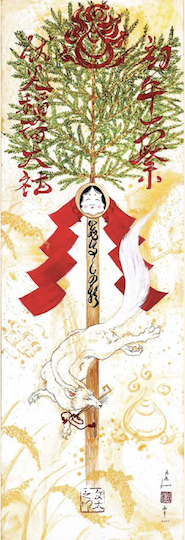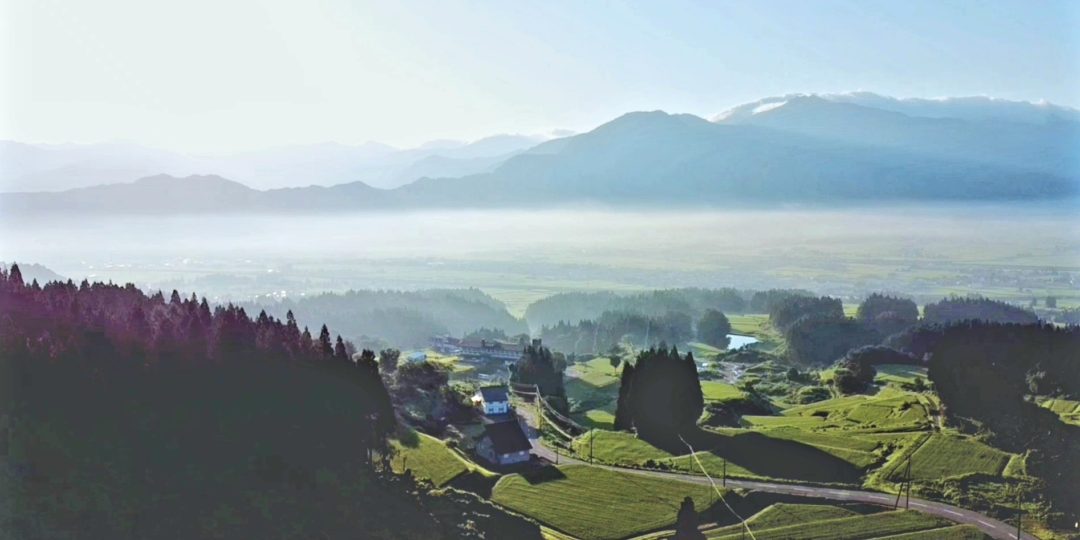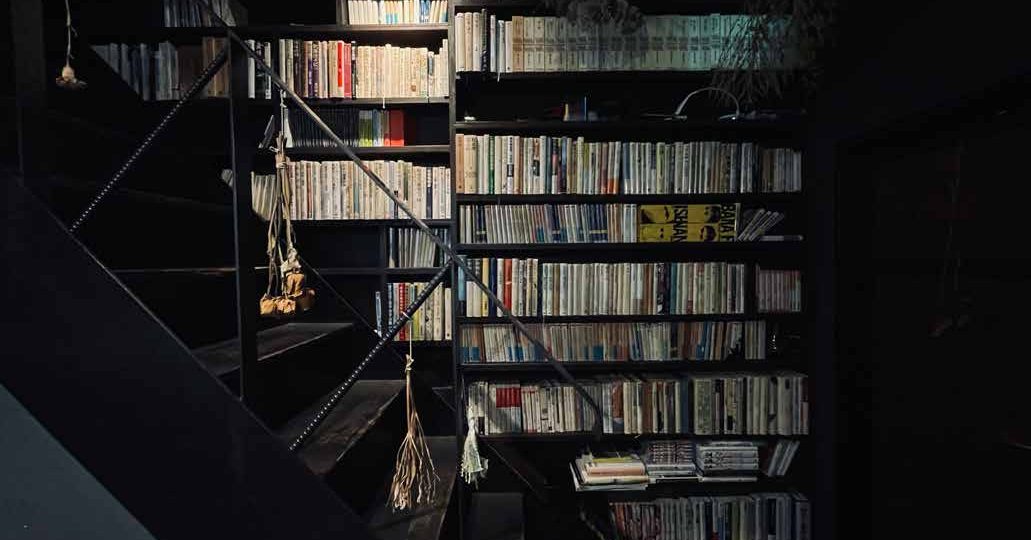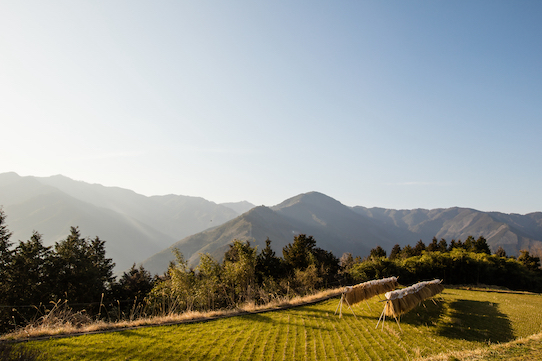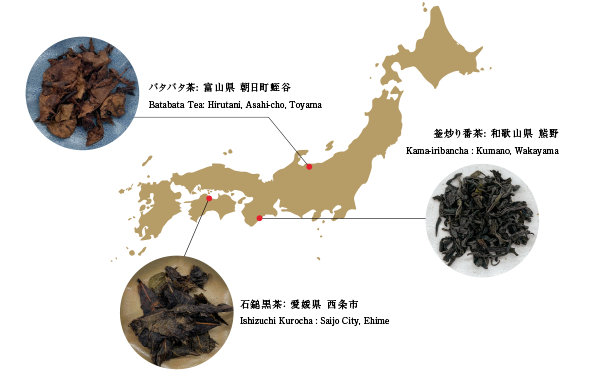-
Fushimi Inari Taisha Hatsuma Taisai
- Hiragana Times
- Jan 22, 2025
Fushimi Inari Taisha Hatsuma Taisai | 伏見稲荷大社初午大祭
[Cover Story – February 2025 Issue]
The cover of this month’s issue features a painting by Bunta Inoue, which was dedicated to the 2024 Hatsuma Taisai at Fushimi Inari Taisha in Kyoto.
今月号の表紙は、井上文太氏が2024年の京都・伏見稲荷大社初午祭に奉納した絵画です。The deity of Inari is known as the guardian of agriculture and commerce, and the key to the rice granary, held in the mouth of the deity’s messenger, the fox, is regarded as a symbol of protecting rice, the fundamental source of life for people.
稲荷神は農業や商業の守護神として知られ、その神使である狐がくわえている米蔵の鍵は、人々の命の根源である米を守る象徴とされています。The main subject of the painting, the “Shirushi no Sugi” (Symbolic Cedar), is cherished as a good luck charm.
絵の主題である「しるし(験)の杉」は、縁起物として親しまれています。Its origins are believed to lie in the Kumano Pilgrimage, which was widely practiced from the Heian to Kamakura periods.
その起源は、平安時代から鎌倉時代にかけて広く行われた熊野詣にあるとされています。The Kumano Kodo is famous as a network of pilgrimage routes that span the mountainous regions of the Kii Peninsula.
熊野古道は紀伊半島の山岳地帯に広がる巡礼路として有名です。It might be called the Japanese version of the Camino de Santiago.
日本のカミーノ・デ・サンティアゴと言えるかもしれません。The people of Kyoto would visit Fushimi Inari Taisha on their way back from the Kumano Pilgrimage and receive a “Shirushi no Sugi” as a token of their pilgrimage’s fulfillment and as a symbol of prayers for the prosperity of their families and communities.
京都の人々は熊野詣の帰路に伏見稲荷大社を訪れ、巡礼成就の証として、そして家族や地域の繁栄を祈願したしるしとして「しるしの杉」を受け取っていました。The Hatsuma Taisai is held on the first “Day of the Horse” (in a 12-day cycle) of the new year, and its key ceremonies take place during the “Hour of the Horse” (11:00 a.m. to 1:00 p.m.).
初午祭は、新年最初の「午の日」(12日周期)に行われ、重要な儀式は「午の刻」(午前11時~午後1時)にとり行われます。In traditional Japanese cosmology, “Horse” represents summer in the seasons, south in direction, and the time when the sun is at its highest point.
「午」は四季では夏、方角では南、太陽が最も高い位置にある時を表します。Originally, the festival’s purpose was to pray for abundant crops in the coming year, timed to this specific day and hour.
この日のこの時間に合わせ、その年の五穀豊穣を祈願するのが初午祭の本来の目的でした。Today, it has become an important event not only for agriculture but also for praying for business prosperity.
現在では、農業だけでなく商売繁盛も祈願する重要な行事となっています。 -
From Ancestry to 6,000 Descendant Varieties: The Lineage of Rice in India
- Hiragana Times
- Nov 18, 2024
From Ancestry to 6,000 Descendant Varieties: The Lineage of Rice in India
祖先から6,000種の子孫へ:インドに生きる稲の系譜
[Spotlights – December 2024 Issue]
We are blessed to partake in the seeds of rice plants.
私たちは、稲の種子であるお米をいただいています。
Rice is believed to have first appeared as a wild species around 10 to 15 million years ago.
稲が野生種として現れ始めたのは約1500万〜1000万年前とされています。
Wild species, such as Oryza rufipogon, began to take root and thrive along the warm, humid riverbanks and wetlands of Southeast and South Asia, signaling the first pulse of life.
温暖で湿潤な東南アジアや南アジアの川沿い・湿地帯に適応したオリザ・ルフィポゴン(Oryza rufipogon)などの野生種が自生するようになりました。
Ancient rice has also been discovered at Jomon-era archaeological sites in Japan, indicating that rice plants have existed on the Japanese archipelago since ancient times.
日本でも縄文時代の遺跡から古代米が発見されており、日本列島でも古くから稲が生息していたとされています。
These wild species originally displayed a trait known as “shattering,” in which seeds naturally fell when ripe. However, humans selected non-shattering mutations, making them easier to harvest, and continued to cultivate them over many generations.
この野生種は、穂が熟すと種子が自然に落ちる「脱落性」をもっていましたが、人類は収穫しやすい「非脱落性」の変異種を選び、何世代にもわたり栽培を続けました。
Eventually, around 9,000 years ago (7,000 BCE), stable paddy rice cultivation practices developed along China’s Yangtze River.
やがて、9000年前(紀元前7000年)頃には、中国の長江流域で安定した水田稲作が発展します。
Japonica rice (found in Japan and China), Indica rice (common in India and Southeast Asia), and other varieties spread across Asia, adapting to and taking root in each region.
ジャポニカ米(日本や中国)、インディカ米(インドや東南アジア)などがアジア各地へ広がり、地域特有の品種がそれぞれ根付いていきました。
Wild rice species still exist today, but in many rice-growing areas worldwide, they are often regarded as an unwelcome form of “weedy rice.”
野生種は現在も存在しますが、世界の稲作地域の多くでは「雑草型イネ」として嫌われています。
In certain regions of India, however, wild rice is respected as a valuable traditional crop, and it is cultivated and harvested using age-old methods.
一方、インドの一部地域では野生種が価値ある伝統的な稲として受け入れられ、昔ながらの手法で栽培・収穫が行われています。
At its core lies a longstanding respect for these ancient species and a deep-seated desire for harmony with the natural environment.
その背景には、長年親しまれてきた野生種への敬意、自然環境との共存を願う心があります。
In Hindu wedding ceremonies, rice symbolizes fertility and union. As part of the ritual, the couple showers each other with handfuls of rice, enveloping each other in blessings and well-wishes for a prosperous future together.
また、ヒンドゥー教の結婚式では米は豊穣と結合の象徴とされ、夫婦が互いに米を振りかけ合って幸運を祈る儀式が行われます。
This ritual is based on the belief that the bride brings prosperity to her new home, symbolizing the cultural and spiritual importance of rice.
これは花嫁が新しい家に富をもたらすという言い伝えに基づいており、米の精神的・文化的な重要性を象徴しています。
India currently cultivates over 6,000 varieties of rice and is the world’s largest rice exporter.
インドでは現在6,000種類以上の米が栽培されており、世界最大の米輸出国となっています。
Just as Buddhism and other philosophical teachings originated in India, the origins of rice can also be traced back to this land.
仏教をはじめとする哲学思想の発祥がインドであるように、米の起原もインドにたどり着きます。
A journey to discover the “root of life (i-ne),” through rice ultimately becomes a journey into the origins of humanity itself.
「イネ(命の根)」を巡る旅は、人類の命のルーツを探る旅となるでしょう。 -
Minamiuonuma City – A Region of Japan Renowned for Its Rice, Cuisine, and Culture
- Hiragana Times
- Nov 18, 2024
Minamiuonuma City – A Region of Japan Renowned for Its Rice, Cuisine, and Culture
南魚沼市——日本屈指の米どころが誇る食と文化
[Place – December Issue 2024]
Niigata Prefecture’s Minamiuonuma City is one of Japan’s foremost rice-producing regions. The premium rice, “Minami-Uonuma-origin Koshihikari brand rice,” is known for its unique stickiness, shine, and fragrant aroma, created by pure snowmelt water and temperature differences between day and night, continually captivating many food enthusiasts.
新潟県南魚沼市は、日本を代表する米どころです。ブランド米「南魚沼産コシヒカリ」は、清らかな雪解け水、昼夜の寒暖差が生み出す独特の粘りと艶、香りの高さで知られ、多くの食通を魅了し続けています。
Minamiuonuma is also one of Japan’s snowiest regions, where the local food culture reflects the snowy environment. For example, vegetables stored in a natural “snow room” (a type of refrigerator that uses snow) gain significantly more sweetness. This preservation method is a tradition of wisdom passed down by ancestors who skillfully harnessed nature’s power.
南魚沼市は全国有数の豪雪地でもあり、雪国ならではの食文化も楽しめます。例えば、雪を利用した天然の冷蔵庫である雪室に貯蔵した野菜は、甘みがグンと増すのです。この保存方法は、自然の力を巧みに利用した先人の知恵の結晶です。The locally produced sake, including the renowned “Hakkaisan,” named after a long-revered sacred mountain, is made from pristine, cold water and high-quality rice, delighting sake enthusiasts nationwide. Additionally, “hegisoba,” a type of soba noodle that uses the seaweed “funori” as a binder, is loved for its unique texture and flavor.
古くから霊山としてあがめられてきた山の名を冠した「八海山」をはじめとする、清らかで冷たい水と良質な米から生まれる日本酒は、全国の酒好きを唸らせます。また、海藻の一種「ふのり」をつなぎに使用した「へぎそば」も、独特の歯ごたえと風味で愛されています。As for cultural heritage, the linen fabric “Echigo jofu” is recognized as a UNESCO Intangible Cultural Heritage, and the silk fabric “Shiozawa tsumugi,” known for its graceful luster, is designated as a traditional craft. These textile industries developed around Shiozawa-juku, a post town along the historic Mikuni Road that once connected Edo and Echigo, and traces of history can still be seen today on “Bokushi-dori Street” in Shiozawa-juku.
文化的遺産としては、麻織物「越後上布」がユネスコ無形文化遺産に、優美な光沢が特徴の絹織物「塩沢紬」が伝統工芸品に指定されています。これらの織物産業は、かつて江戸と越後を結んだ三国街道の宿場町だった塩沢宿[ルビ:しおざわじゅく]を中心に発展し、現在も「塩沢宿 牧之通り」に歴史の面影が残ります。In spring, the “snow bleaching” of Echigo jofu is performed. This traditional technique uses snow to bleach the fabric, and the sight has long been a hallmark of the season.
春には越後上布の「雪ざらし」が行われます。雪を利用して布を漂白する伝統的な技法で、その光景は古くから春の風物詩となっています。Another attraction in Minamiuonuma is the abundance of hot springs nurtured by snowmelt. The various hot springs scattered across the city each have unique mineral qualities that soothe both body and mind.
雪解け水が生み出す豊富な温泉も南魚沼市の魅力の一つです。各所に点在する温泉地では、それぞれの独特の泉質が人々の心身を癒やしています。
The picturesque landscapes shaped by rich nature, culinary culture, and tradition leave a beautiful and lasting impression on visitors to Minamiuonuma City.
豊かな自然、それを活かした食文化と伝統が織りなす風景は、南魚沼市を訪れた人に美しい余韻を残してくれることでしょう。(Access)
・Approximately 1 hour and 30 minutes by Joetsu Shinkansen from Tokyo Station to Echigo-Yuzawa Station, followed by about 15 minutes from Echigo-Yuzawa Station to Shiozawa Station via the JR Joetsu Line or Hoku Hoku Line.
・Approximately 2 hours and 30 minutes by car from Tokyo (Nerima IC) via the Kan-Etsu Expressway.
・About 2 hours by car from Niigata Airport.
(アクセス)
・東京駅から上越新幹線で越後湯沢駅まで約1時間30分、越後湯沢駅からJR上越線またはほくほく線で塩沢駅まで約15分
・東京(練馬IC)から関越自動車道利用で約2時間30分
・新潟空港から車で約2時間
-
A new café blending into Jimbocho — Mafumi Coffee and Books
神保町になじむ新しい喫茶店——眞踏珈琲店[Spotlight – November 2024 Issue]
Mafumi Coffee and Books, which opened in 2016 in Jimbocho (Chiyoda Ward, Tokyo), one of Japan’s most famous secondhand book districts, is still a relatively new presence in the area. The owner, Mr. Mafumi Oyama, is also a sociology researcher with fieldwork experience in the United States.
日本屈指の古書店街である神保町(東京都千代田区)に2016年にオープンした「眞踏珈琲店」は、この町ではまだ新しい存在です。店主の大山眞踏さんは社会学研究者でもあり、米国でのフィールドワーク経験もあります。
The roughly 5,000 books lining the shop’s shelves are mostly from Mr. Oyama’s personal collection. Inside the remodeled standalone house, there is a large counter on the first floor, and the second floor, as well as the stairs, are packed with books. The shelves hold books from a wide range of genres, including literature, philosophy, and sociology.
店内に並ぶ約5,000冊の本の大半は、大山さんの私物です。一軒家を改装した店内には1階に大きなカウンターがあり、2階、そして階段にも所狭しと蔵書が並んでいます。棚にあるのは、文学、哲学、社会学など多岐にわたるジャンルの本です。The reason Mr. Oyama opened the café stems from his deep affection for a café where he once trained. He was strongly drawn to the relationships between the customers and the atmosphere of that café. He chose Jimbocho because he felt a connection with the town’s culture, which is home to many long-standing cafés that have been around for 50, 60, or even 70 years. It also suited his own love of books.
大山さんがこの店を開店したきっかけは、深く愛着を持って修業していた喫茶店での経験です。そこでのお客様と店の関係性や雰囲気に強く惹かれたといいます。神保町を選んだのは、50年、60年、70年と長く続く老舗の喫茶店が数多ある町の文化と、本好きの自分の気質が合ったからだそうです。At the café, Mr. Oyama roasts the beans himself and uses the nel drip method to brew coffee, respecting the freedom of how customers choose to spend their time. Some people might feel intimidated by coffee specialty shops, but at Mafumi Coffee and Books, it’s perfectly fine to chat, read a book, or just daydream. The shop stays open until 11 p.m. on weekdays to make it easy for people to drop by after work.
店では、大山さん自身が焙煎した豆をネルドリップで淹れ、お客さんの自由な過ごし方を尊重しています。コーヒー専門店に敷居の高さを感じてしまうという人もいますが、この眞踏珈琲店では雑談をしても、本を読んでも、ぼんやりしていても構いません。平日に23時まで営業しているのは、仕事帰りの人も気軽に立ち寄れるようにという考えからです。Mr. Oyama puts his heart into each daily cup of coffee, aiming for the shop to last “50 years, or ideally even 100 years.”
大山さんは「50年、できれば100年後も残る店でありたい」と、日々の1杯のコーヒーに思いを込めています。Every autumn in Kanda-Jimbocho, the “Kanda Secondhand Book Festival” is held. In 2024, it is scheduled from October 25 to November 4. Many people will likely take a break at Mafumi Coffee and Books while browsing for books.
神田神保町では毎年秋に「神田古本まつり」が開催され、2024年は10月25日から11月4日までの予定です。本選びの合間に、眞踏珈琲店で一息つく人も多いことでしょう。Photo: Mafumi Coffee and Books
Text: IKEDA Miki写真提供:眞踏珈琲店
文:池田美樹 -
Shiiba Village, Miyazaki Prefecture: A Hidden Mountain Sanctuary Where History and Culture Live On
- Hiragana Times
- Oct 19, 2024
Shiiba Village, Miyazaki Prefecture: A Hidden Mountain Sanctuary Where History and Culture Live On
宮崎県椎葉村——歴史と文化の息づく山岳地帯の秘境[Place – November 2024 Issue]
Deep in the mountains of Kyushu lies Shiiba Village in Miyazaki Prefecture. Alongside Shirakawa-go in Gifu Prefecture and Iya in Tokushima Prefecture, it is considered one of Japan’s three great hidden regions. This mystical village, situated in a rugged, densely forested mountainous area, is dotted with small settlements.
九州山地の奥深くに位置する宮崎県椎葉村。ここは、岐阜県の白川郷、徳島県の祖谷[ルビ:いや]と並ぶ日本三大秘境の一つ、険しく緑深い山岳地帯に集落が点在する神秘的な村です。
In the village, a distinctive culture has flourished in the daily lives of its people for centuries. “Shiiba Kagura,” a sacred dance dedicated to the gods, has been passed down for over 600 years and is performed throughout the night. This kagura was designated as an Important Intangible Folk Cultural Property by the Japanese government in 1978 and remains one of the village’s greatest sources of pride.
村では、古くから人々の生活に特色ある文化が息づいています。600年以上受け継がれてきた「椎葉神楽」は神々への奉納の舞で、夜を徹して行われます。この神楽は1978年に国の重要無形民俗文化財に指定され、村の誇りのひとつとなっています。The village is also known for its stunning natural beauty. Highlights include the “Okubo No Hinoki” cypress tree, which is over 800 years old and designated as a National Natural Monument, and the towering “Yamura Sugi,” which stands 54.4 meters tall. The moss-covered trees in the wetlands of Shiratori Mountain are often enveloped in thick mist, and the area is revered as a sacred place by the villagers.
大自然も村の魅力のひとつです。国の天然記念物である樹齢800年の「大久保のヒノキ」や、54.4mの高さを誇る「八村杉」など、そのスケールは人々を圧倒します。苔むした木々が立ち並ぶ白鳥山の湿地帯は時に霧が深く立ちこめ、村人に聖地としてあがめられています。Shiiba Village is also famous as the place where the survivors of the Taira clan, who were defeated in the Battle of Dan-no-ura at the end of the Heian period, took refuge. Their sorrowful yet beautiful story is still passed down today, reminding people that Shiiba was an important chapter in Japan’s history.
椎葉村は、平安時代末期に壇ノ浦の戦いで敗れた平家の落人たちが隠れ住んだ場所としても知られています。彼らの悲しくも美しい物語は今も語り継がれ、椎葉村が歴史の重要な舞台であったことを伝えています。The village preserves the traditional Japanese rural landscape, featuring terraced rice fields and stone walls. Particularly notable is the traditional slash-and-burn farming, which has been recognized for its contributions to environmental preservation, earning it a designation as a Globally Important Agricultural Heritage Site in 2015.
集落には棚田や石垣など、昔ながらの日本の農村の景観が残されています。特に、伝統的な焼畑農業は環境保全の観点からも評価され、2015年に世界農業遺産に認定されました。Shiiba Village is a mystical place where culture, history, and nature intertwine. This hidden sanctuary, untouched by the passage of time, leaves a profound and lasting impression on all who visit.
文化、歴史、そして自然が織りなす神秘の舞台、椎葉村。この秘境は、時代の波に揺るがぬ魅力を放ち、訪れる者の胸に深く刻まれることでしょう。Access
Approximately 1 hour and 45 minutes from Haneda Airport to Miyazaki Airport, followed by a 1 hour and 30 minute train ride on the JR Nippo Main Line from Miyazaki Airport Station to Hyuga City Station, and then a 2 hour and 30 minute bus ride from Hyuga City Station.
・About a 3-hour drive from Miyazaki City.
・About a 2-hour and 15-minute drive from Kumamoto City.アクセス
羽田空港から宮崎空港まで約1時間45分、JR日豊本線宮崎空港駅から日向市駅まで1時間30分、日向市駅から路線バスで約2時間30分
・宮崎市より車で約3時間
・熊本市より車で約2時間15分 -
Japanese tea we don’t want to lose
- Hiragana Times
- Feb 20, 2024
Japanese tea we don’t want to lose – 失いたくない日本のお茶
[Spotlights – March 2024 Issue]
The origins of tea culture in Japan can be traced back to the early Heian period (around the 9th century). It is believed to have begun when the Buddhist monk Saicho returned with a handful of tea seeds from China and planted them at the base of Mount Hiei.
日本におけるお茶文化の始まりは、平安時代初頭(9世紀頃)までさかのぼります。仏教僧である最澄が中国から持ち帰った一握りのお茶の種を、比叡山の麓[ふもと]に植えたことから始まったと言われています。
Initially a luxury item, tea eventually found its way into the everyday life of the common people. In the 16th century, Sen no Rikyu formalized the tea ceremony, marking a significant evolution in its cultural status. The arrival of Commodore Perry in 1853 sparked an increase in tea exports, elevating tea to a globally recognized emblem of Japan’s exquisite culture.
当初は高級品でしたが、次第に庶民の間でも飲まれるようになりました。16世紀には、千利休が茶道を確立。ペリー来航(1853年)をきっかけに、海外への輸出が盛んになり、お茶は日本が世界に誇る文化の一つとなりました。
Currently, Japan is home to over 100 varieties of Japanese tea. However, amidst these, some are facing the threat of extinction due to a shortage of producers and evolving production environments. These are ‘endangered teas’.
現在、日本には100種類以上の日本茶が存在すると言われています。そんな中、生産者不足や生産環境の変化により、絶滅の危機にさらされているお茶があります。それが「絶滅危惧茶」です。
CLASS EARTH Inc., is working to protect endangered traditional Japanese teas as part of a project aimed at restoring biodiversity. In January 2024, the company began selling Wakayama Prefecture’s “Kama-iribancha”, Toyama Prefecture’s “Batabatacha” tea, and Ehime Prefecture’s “Ishizuchi Kurocha” as its first endangered tea products. All teas have a rich individual taste and are produced using traditional methods in each region. Part of the proceeds from selling these teas will be donated to WWF Japan, an environmental conservation organization.
CLASS EARTH株式会社は、生物多様性の回復を目的とした事業の一環として、絶滅の危機にある日本の伝統茶を守る活動をしています。2024年1月には、絶滅危惧茶の第一弾として和歌山県「釜炒り番茶」、富山県「バタバタ茶」、愛媛県「石鎚黒茶[いしづちくろちゃ]」の販売を開始。いずれも各地の伝統的な製法で作られる個性豊かな味わいのお茶です。これらの売上の一部は、環境保全団体のWWFジャパンに寄付されます。
The packaging of the endangered tea depicts a bonsai tree. The bonsai, which can live a long and beautiful life with human care, was used to express the wish for the survival and prosperity of endangered tea.
絶滅危惧茶のパッケージには盆栽が描かれています。人間が手入れをすることで永く美しく生きることができる盆栽に、絶滅危惧茶の存続と繁栄の願いを込めたそうです。
The tea produced in each region symbolizes the nature and culture of the region and the history of the people who live there – a cup of tea may allow us to think about environmental issues and the planet’s future and raise awareness of sustainable living.
各地で生産されるお茶は、その土地の自然や文化、そこで暮らす人々の歴史を象徴しています。1杯のお茶が、私たちに環境問題や地球の未来について考える機会を与え、持続可能な生活への意識を高めるきっかけになるかもしれません。
文:澤口夏紀
Text: SAWAGUCHI Natsuki
Information From Hiragana Times
-
 February 2026 Issue
January 21, 2026
February 2026 Issue
January 21, 2026 -
 January 2026 Issue – Available as a Back Issue
January 15, 2026
January 2026 Issue – Available as a Back Issue
January 15, 2026 -
 December 2025 Issue —Available as a Back Issue
November 20, 2025
December 2025 Issue —Available as a Back Issue
November 20, 2025

